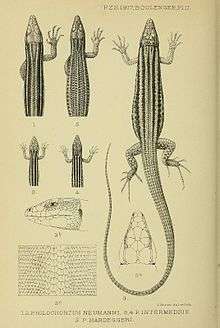Philochortus
| Philochortus | |
|---|---|
| Scientific classification | |
| Kingdom: | Animalia |
| Phylum: | Chordata |
| Subphylum: | Vertebrata |
| Class: | Reptilia |
| Order: | Squamata |
| Suborder: | Sauria |
| Infraorder: | Scincomorpha |
| Family: | Lacertidae |
| Subfamily: | Lacertinae |
| Genus: | Philochortus Matschie, 1893. |
| Species | |
|
See text. | |

Philochortus is a genus of lacertid lizards of the family Lacertidae. Species of this genus are distributed in Egypt, Algeria, Libya, Mali, Niger, Ethiopia, Djibouti, Eritrea, Somalia, Kenya, Yemen, and Saudi Arabia. [1]
Etymology
Philochortus means grass-loving (gr. philos= friend, chortos= grass).[2] The common name of Philochortus species is therefore Grass-loving Lizards or Shield-backed Ground Lizards because of their typical back scalation.
Diagnosis
Species of Philochortus are medium to large-sized lacertids with long cylindrical tails. The unregenerated tail is up to 3.25 times longer than head and body. Eyes with movable lids. The nostril is pierced between two shields and usually bordered by the first supralabial or narrowly separated from it. The collar is well marked. The ventral plates are smooth, feebly imbricate and arranged in 6 longitudinal series. The dorsal scales are smooth or keeled. Back with 2 to 6 longitudinal series of enlarged plate-like scales along the dorsal mid-line. This is the main difference to Latastia. Femoral pores are present on the inside of the thighs, more prominent in males. Tail base in males much broader than in females.[3]
Habitat and natural history
The natural history of all species is only poorly known. Many species of Philochortus inhabit semiarid, arid or hyperarid regions, mountainous areas as well as plains from sea level up to 1500 m altitude (P. neumanni). Most species prefer sparsely vegetated, open and sandy or fairly rocky localities (P. neumanni) and can be found in Acacia-Commiphora deciduous bushland and semidesert bushland vegetation types. But P. zolii and P. neumanni can be found also in marginal unattended cultivated areas with Halfa grass and other scrub and well vegetated natural habitats.[4][5][6]
The species of Philochortus are diurnal, sun-loving active predators on insects and other arthropods, egg-laying and terrestrial but P. zolii is an avid climber. The long stiff tail is aiding in balance on vegetation. They dig burrows in the soil below clumps of grasses or small bushes.[6]
Species
The following six species are recognized as being valid.[7]
- Philochortus hardeggeri (Steindachner, 1891)
- Philochortus intermedius Boulenger, 1917
- Philochortus neumanni Matschie, 1893
- Philochortus phillipsii (Boulenger, 1898)
- Philochortus spinalis (Peters, 1874)
- Philochortus zolii Scortecci, 1934
However, some authors[5][8][9] recognize a seventh species, Philochortus rudolfensis Parker, 1932 from northern Kenya. It was previously considered a junior synonym of P. intermedius. They suggest that the two taxa are unlikely to be closely related due to apparent differences in their habitat requirements.

Nota bene: A binomial authority in parentheses indicates that the species was originally described in a genus other than Philochortus.
References
- ↑ The Reptile Database. www.reptile-database.org.
- ↑ Schleich et al. 1996
- ↑ Boulenger 1921
- ↑ Parker 1942
- 1 2 Spawls et al. 2002
- 1 2 Baha El Din 2006
- ↑ "Philochortus ". The Reptile Database. www.reptile-database.org.
- ↑ Largen & Spawls 2006
- ↑ Spawls, S. & Malonza, P. 2014. Philochortus rudolfensis. The IUCN Red List of Threatened Species 2014: e.T21268095A21268221. http://dx.doi.org/10.2305/IUCN.UK.2014-3.RLTS.T21268095A21268221.en.
Further reading
- Baha El Din, S. 2006. "A Guide to the Reptiles and Amphibians of Egypt". The American University in Cairo Press, Cairo - New York.
- Boulenger, G.A. 1898. "On a second collection of reptiles made by Mr. E. Lord-Phillips in Somaliland". The Annals and Magazine of Natural History (7) 2: 130-133. (P. phillipsii, new species)
- Boulenger, G.A. 1917. "On the lizards of the genus Philochortus MATSCHIE". Proceedings of the Zoological Society of London, 1917: 145-157. (P. intermedius, new species).
- Boulenger, G.A. 1921. "Monograph of the Lacertidae. Vol. II". British Museum (Natural History). Department of Zoology. London. 451 pp.
- Largen, M.J. and Spawls, S. 2006. "Lizards of Ethiopia (Reptilia Sauria): an annotated checklist, bibliography, gazetteer and identification key". Tropical Zoology 19: 21-109.
- Matschie, P. 1893. "Über einige von Herrn Oscar Neumann bei Aden gesammelte u. beobachtete Säugethiere, Reptilien und Amphibien". Sitzungs-Berichte der Gesellschaft Naturforschender Freunde zu Berlin 1893: 24-31. (Philochortus, new genus, p. 30; P. neumanni, new species). (in German).
- Parker, H.W. 1932. "Scientific results of the Cambridge expedition to the east African lakes, 1930-31. 5. Reptiles and amphibians". The Journal of the Linnean Society of London. Zoology 38: 213-229. (P. intermedius rudolfensis, new subspecies).
- Parker, H.W. 1942. "The Lizards of British Somaliland". Bulletin of the Museum of Comparative Zoology at Harvard College]] 91 (1): 1-101.
- Peters, W.C.H. 1874. "Über einige neue Reptilien (Lacerta, Eremias, Diploglossus, Euprepes, Lygosoma, Sepsina, Ablepharus, Simotes, Onychocephalus)". Monatsberichte der Königlichen Preussischen Akademie der Wissenschaften zu Berlin 1874: 368-377. (P. spinalis, new species)
- Schleich, H.H., Kästle, W. & Kabisch, K. 1996. "Amphibians and Reptiles of North Africa". Koeltz Scientific Books, Königstein.
- Scortecci, G. 1934. "Descrizione preliminare di una nuova specie del genere Philochortus (Philochortus zolii) della zona Gat (Missione della Reale Società Geografica)". Atti Soc. Italiana Sci. Nat. 73: 305-308. (Philochortus zolii, new species). (in Italian).
- Spawls, S., Howell, K.M., Drewes, R.C. and Ashe, J. 2002. "A Field Guide to the Reptiles of East Africa". Academic Press, Elsevier Science, San Diego, San Francisco, New York, Boston, London.
- Steindachner, F. 1891. "Ueber neue und seltene Lacertiden aus der herpetologischen Sammlung des k. k. naturhistorischen Hofmuseums". Annalen des Naturhistorischen Museums in Wien 6: 371-378. (P. hardeggeri, new species)